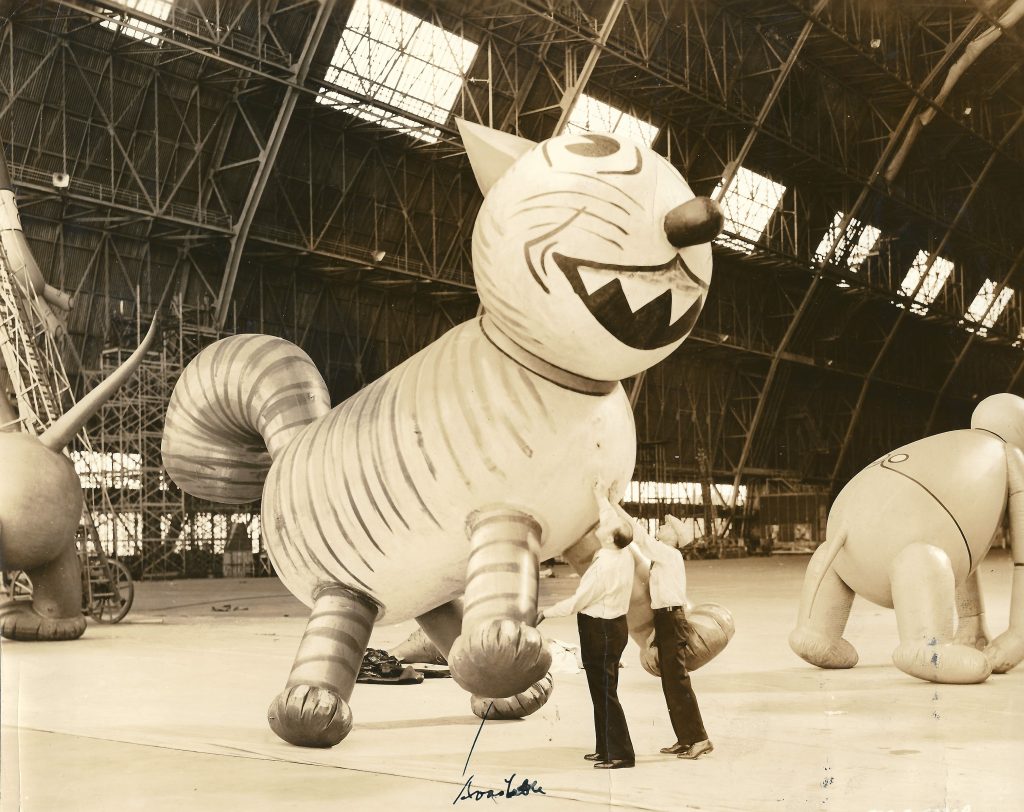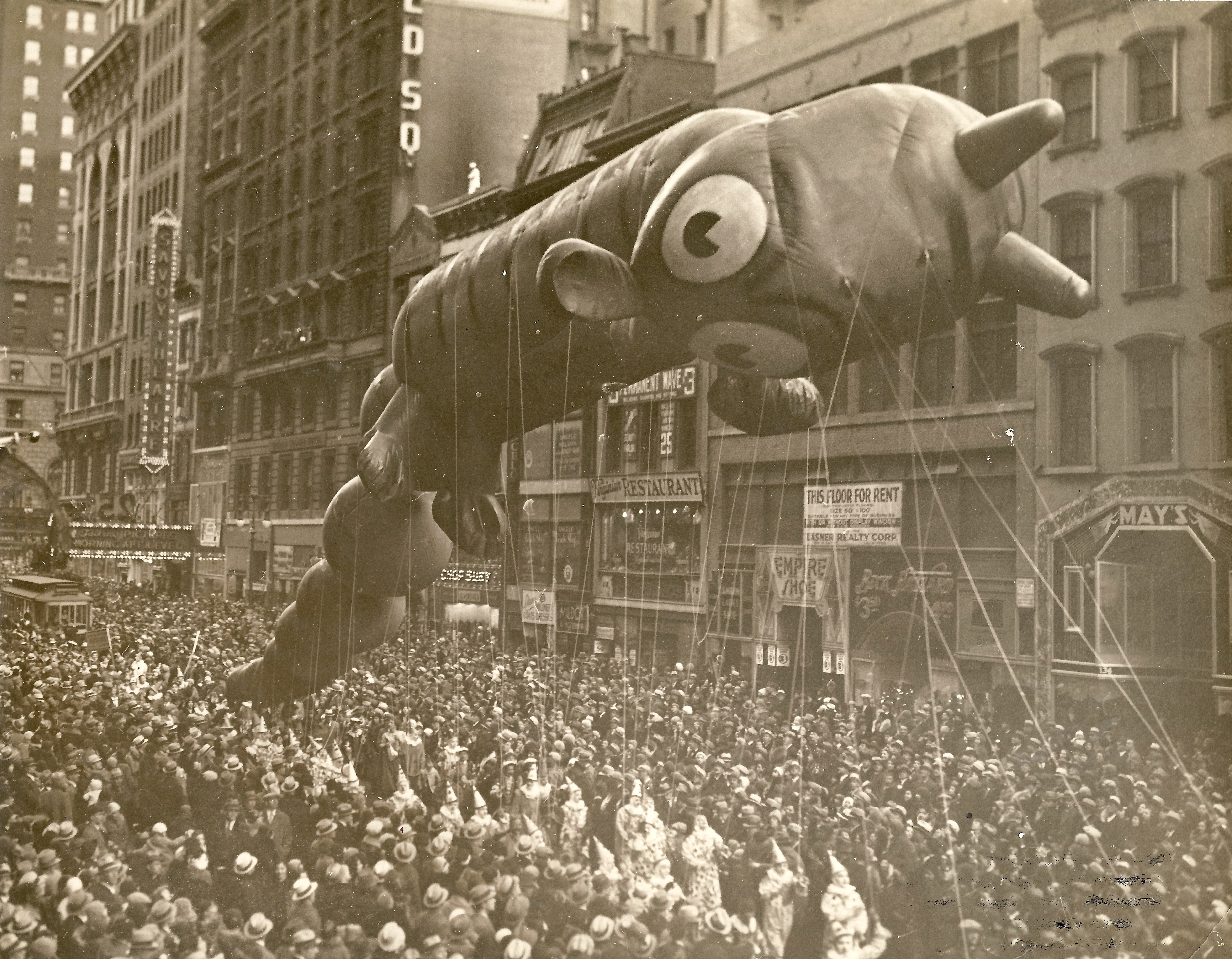[Editor’s Note: Last year, a Puppetry Forum at the Ballard Institute and Museum of Puppetry (BIMP) focused on the history of the world-famous character balloons of the Macy’s Thanksgiving Day Parade and prompted this story. This year’s 94th edition of the parade will be a television-only event due to pandemic safety precautions. The annual production will forgo marching down the traditional 2.5-mile route in Manhattan in order to avoid gathering large crowds. Instead, it was reimagined over the course of several days, leading up to a live Thanksgiving Day broadcast featuring its signature elements, including traditional animated floats, street performances, and giant character balloons. We are presenting last year’s story again as a small indicator that, despite the changes to holiday celebrations in response to the pandemic, annual traditions still endure.]
At first glance, the Ballard Institute and Museum of Puppetry (BIMP) may not seem to be the place for a forum about the annual Macy’s Thanksgiving Parade with its marching bands, floats, celebrity performers, and those flying balloon characters moving through midtown Manhattan.
That is, until you hear Macy’s Parade historian Robert M. Grippo discuss the origin of the parade.
“What is a Macy’s balloon?” he asked an audience at BIMP last week. “Think about it. It’s an upside-down puppet, a marionette. Tony Sarg came up with idea; let’s flip this thing upside down. Helium gave them the ability to that. It’s a stroke of genius.”
Sarg was a puppeteer originally hired by Macy’s to design a holiday window display in its flagship store on 34th Street in New York City in the early 1920s. In 1924 the department store was expanding its space at Herald Square, and Sarg, the son of a German diplomat, developed the idea of a parade in the tradition of celebratory festivals fondly recalled by Macy’s large group of employees who had emigrated from Europe.
The early events were known as Macy’s Christmas Parade and featured employees dressed in colorful costumes, professional bands, floats, and animals from the Central Park Zoo. Santa Claus was also part of the parade.
This month, Grippo and Christopher Hoskins, authors of Macy’s Thanksgiving Day Parade (Arcadia Publishing) joined John Bell, historian of puppetry and director of BIMP, for a discussion about the parade moderated by Mehdi Anwar, professor of electrical and computer engineering.
Grippo said balloons were first introduced to the parade in 1927, replacing the zoo animals. Two years later, he says, Sarg decided to introduce more familiar characters.
“The first few balloons were very generic; elephant, bird, dragon,” he said. “This is the genius of Sarg. He reaches out to the creators of the Katzenjammer Kids, you see Mama Katzenjammer, the first female character in the parade. He goes to branding and he goes to famous characters to sell the parade. He’s now creating characters of famous comics and cartoons.”
The Katzenjammer Kids was a comic strip created by Rudolph Dirks in 1897 that ran until 2006.
Anwar said the annual parade today costs about $12 million, with approximately $9 million allocated for costumes and supplies. Filling all balloons costs more than $500,000. Sponsoring a brand new balloon costs $190,000, and then $90,000 for each consecutive year.
“The balloon shells now are made of fabric coated with polyurethane, a type of plastic that takes color well and is flexible,” Anwar said. “This is a departure from the original design when the figures were made of rubber.”
Each balloon contains about 120,000 cubic feet of helium and could lift 750 pounds, Anwar noted. It takes about 90 minutes to inflate each balloon.

Hoskins, a photographer who work at Macy’s for several years and participated as a balloon handler, said he and Grippo didn’t find much available information when they first decided to write their book.
“There was no historian. We started researching backward. We’d find the information, find the photograph that would confirm what we’d found,” he said, noting they contacted archivists at the New York Daily News, Goodyear Tire and Rubber Company, Lockheed Martin, 20th Century Fox Film Corporation, and BIMP.
He added: “Even though we think of Macy’s with celebrities, floats and marching bands, the stars of the parades have always been the giant balloons. The genesis of the giant balloons is puppetry. The look of a balloon comes from puppetry. It’s evolved over the years.”
Bell said there are three distinct periods for balloon puppets, starting with Sarg and his work and partnership with Goodyear as the designer and builder of the balloons. The parades were suspended during World War II, which coincided with Sarg’s death. The era of Goodyear’s balloons continued until the involvement of Jean McFaddin, who served as Macy’s events planner for nearly a quarter century. During her tenure, she introduced major characters such as Kermit the Frog, Spider-Man, Clifford the Big Red Dog, and Blue of Blue’s Clues.
Grippo noted that scenes from the parade included in the classic 1946 film “Miracle on 34th Street” provided worldwide exposure for the parade and Macy’s.
Anwar said the opportunity to participate in the forum, which was co-sponsored by the School of Fine Arts and the School of Engineering, demonstrates the collaboration of disciplines at UConn.
“One simple way to generate new ideas is to look at other seemingly uncorrelated disciplines. That’s why I’m here today. Most of the interesting science and engineering seems to lie at this particular interface of seemingly dissimilar disciplines. We do not discover as engineers; we create. A sentiment that was best articulated by Theodore Von Karman: scientists discover the world that exists, engineers create the world that never was.
“In electrical engineering, we facilitate communication –the cell phone. Puppetry is communication. That is the link that I see in between the two. Engineering is the art of making approximations. Making things better, making them safe, structurally stable and, most importantly, affordable. We see that the progression in the design of inflatable characters from artistic rendition to CAD-CAM, going from rubber to polyurethane, going from oxygen to mixed of helium and air, now to helium, the use of pneumatics to give expressions and movements to create a new generation of characters , creating a new electronic platform for visual puppetry.
“What’s next? Self-learning puppets? Utilizing the ongoing research on deep learning? Will they morph into something different, like the Transformers? The future is rather exciting not only for puppetry, but also for engineering. We not only adapt, we adopt. Whatever we see good, we borrow it.”



